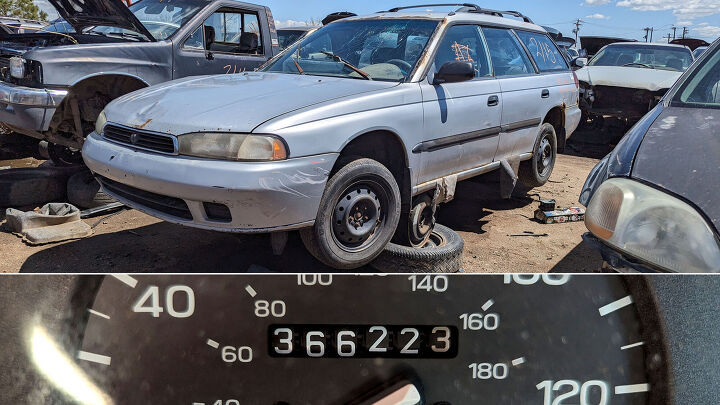When it comes to junkyard cars with impressively high final odometer numbers, Toyotas, Hondas, Volvos and Mercedes-Benzes seem to be the most likely to have driven better than 400,000 miles during their lives. How about Subaru? Well, today’s Junkyard Find is the highest-mile discarded Fuji Heavy Industries product I’ve ever found.

I live in Colorado, where Subarus are everywhere and the car graveyards are well-stocked with everything from early Leones to mangled WRXs, so I find a lot of these cars.

These days, the most common Colorado junkyard Subarus are members of the Legacy family, mostly Outback wagons of the late 1990s through middle 2000s. Since I own a 2004 Outback wagon, this makes it very easy for me to find parts (which is a good thing because 10-plus-year-old Subarus tend to nickel-and-dime you with broken interior trim pieces and failed electrical components).

Unfortunately for junkyard historians, Subaru only went to six-digit odometers on U.S.-market vehicles in 1981 (1993 for the Justy) and went to electronic odometers (which are tough, though not impossible, to read in the junkyard) for the 2000 model year.

Prior to today’s Legacy, the highest-mile junkyard Subaru I’d found was a 1998 Legacy Outback wagon with 341,418 miles. Then there’s a 334,735-mile ’98 Legacy sedan I haven’t yet written about, a 324,780-mile ’87 GL wagon and a first-year Impreza wagon with 319,554 miles.

Meanwhile, I don’t even bother documenting Hondas or Toyotas showing fewer than 400K miles these days (unless they’re interesting for other reasons), and I see plenty of those cars. In my opinion, Subaru components just aren’t as good as the ones in Hondas and Toyotas, which pains me to write as the owner of the aforementioned beater Outback wagon plus a Sambar Dias Maleza kei van.

It’s common to blame head gaskets and/or transmissions for the untimely demise of Subarus, but I think it’s more the accumulation of small, annoying problems that dooms these cars. I’ve had to replace just about every exterior light bulb socket (plus several taillight harness connectors) in my Outback, for example.

The head gaskets in my 160K-mile Outback are doing fine and its manual transmission means I haven’t experienced the drivetrain difficulties that seem to plague two-pedal-equipped members of the 2000-2004 Legacy family (the clutch lasted about 145,000 miles, which I think is respectable for an AWD car). I do all the maintenance at factory-recommended intervals and fix whatever breaks, and it has been a fundamentally reliable (though increasingly battered-looking) machine for the household.

This car may well have been a runner at the end, but not many used-car shoppers today are willing to buy a rusty non-truck with the wrong number of pedals and a scary-looking number on the odometer.

1995 was the first model year for the second-generation Legacy in the North American market, just one year after its Leone predecessor ( known as the Loyale during its final years) finally got discontinued here. The original Legacy had its U.S.-market debut as a 1990 model.

Subaru introduced the Outback package for the Legacy wagon (and the Impreza) in 1995, while the Outback-ized Legacy sedan was called the SUS (Sport Utility Sedan) at first. This car is a Legacy L AWD wagon, which was the starting point for the Outback package (which at the time got you a two-tone paint job, slightly lifted suspension and fog lights).

1995 was also the final year in which American Subaru shoppers could buy new cars with front-wheel-drive. The final four-wheel-drive (as we understand the term today) new Subarus sold here were 1994 models. I’ve spent years trying to find a junkyard 1995 Legacy or Impreza with front-wheel-drive, so far without success.

The MSRP for this car would have been $16,955, or about $35,233 in 2024 dollars.

The engine is a 2.2-liter SOHC boxer-four, rated at 135 horsepower and 140 pound-feet.

Manual transmissions had fallen way out of favor with American car buyers by the middle 1990s, but this car has the base five-speed manual. The automatic added an even grand to the price of the Legacy L ($2,078 after inflation).

It was built in Lafayette, Indiana, as was the 341K-mile ’98 Legacy wagon. That makes this car the eighth-best-traveled vehicle built in the United States that I’ve documented in a junkyard, just behind a 1996 Toyota Avalon with 389,077 miles.

1995 Subaru Legacy wagon with 360k miles in Colorado junkyard.

1995 Subaru Legacy wagon with 360k miles in Colorado junkyard.

1995 Subaru Legacy wagon with 360k miles in Colorado junkyard.

1995 Subaru Legacy wagon with 360k miles in Colorado junkyard.

1995 Subaru Legacy wagon with 360k miles in Colorado junkyard.

1995 Subaru Legacy wagon with 360k miles in Colorado junkyard.

1995 Subaru Legacy wagon with 360k miles in Colorado junkyard.

1995 Subaru Legacy wagon with 360k miles in Colorado junkyard.

1995 Subaru Legacy wagon with 360k miles in Colorado junkyard.

1995 Subaru Legacy wagon with 360k miles in Colorado junkyard.
[Images: The Author]
Become a TTAC insider. Get the latest news, features, TTAC takes, and everything else that gets to the truth about cars first by subscribing to our newsletter.

